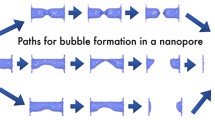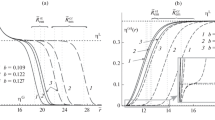Abstract
Equilibrium 3D density profiles in droplets around solid lyophilic spherical particles in under- and supersaturated vapor and in thin concentric vapor shells on lyophobic particles in stretched and stable liquid have been found within the molecular density functional theory with hard-sphere correlations taken into account via the fundamental measure theory. The existence of stable drops and bubbles is confirmed, their structure is described, and threshold values of the chemical potential of vapor and liquid for barrierless nucleation are found. The results show a qualitative agreement with previous ones obtained by us within other versions of molecular density functional theory.
Similar content being viewed by others
Avoid common mistakes on your manuscript.
INTRODUCTION
It is widely known that condensation in the earth’s atmosphere occurs at low vapor supersaturations due to the presence of submicron hydrophilic aerosol particles serving as nucleation cores. This fact was thermodynamically explained in [1] as a consequence of the overlap of surface layers in a thin liquid film around hydrophilic particles. The thermodynamic results are extended to the kinetics of heterogeneous condensation in [2] and confirmed by calculations within the gradient molecular density functional (MDF) theory [3–5]. Recently, using the gradient and integral MDF theories, we have shown [6–9] that not only can stable vapor droplets form around solid lyophilic particles, but thin stable concentric vapor shells–bubbles can appear around lyophobic particles in a stretched liquid. Such drops and bubbles correspond to local minima of a grand thermodynamic potential of the system of the new phase nucleus, the initial phase, and the nucleation core. The aim of this communication is to study stable drops and bubbles on lyophilic and lyophobic nucleation cores using the modern MDF theory with the most complete allowance for hard-sphere correlations according to the fundamental measure theory (FMT) [10, 11].
TWO VERSIONS OF THE DENSITY FUNCTIONAL THEORY
Let us consider a system consisting of a Lennard-Jones fluid around a nucleation core, which creates an external potential for fluid molecules \({{w}_{{{\text{ext}}}}}({\mathbf{r}})\). In the framework of the MDF theory, a grand thermodynamic potential is given by the relation [12]
where \(\rho ({\mathbf{r}})\) is the local density of the inhomogeneous fluid, \(\mu \) is the chemical potential of the fluid molecules, integration in (1) is carried out over the volume of the fluid, \({{F}_{{{\text{id}}}}}[\rho ({\mathbf{r}})]\) is an ideal gas contribution, and \({{F}_{{{\text{hs}}}}}[\rho ({\mathbf{r}})]\) represents the contribution from the hard-sphere repulsion and \({{F}_{{{\text{attr}}}}}[\rho ({\mathbf{r}})]\) from the long-range attraction of fluid molecules.
Below we consider two versions of the MDF theory. The first version [12] is based on the gradient approximation \({{F}_{{{\text{attr}}}}}[\rho ({\mathbf{r}})] = \) \(\int {d{\mathbf{r}}\,\left( { - a\rho {{{({\mathbf{r}})}}^{2}} + {{(C} \mathord{\left/ {\vphantom {{(C} 2}} \right. \kern-0em} 2}){{{(\nabla \rho ({\mathbf{r}}))}}^{2}}} \right)} \), where \(a\) and \(C\) are constants and the Carnahan–Starling approximation \({{F}_{{{\text{hs}}}}}[\rho ({\mathbf{r}})] = {{k}_{{\text{B}}}}T\int {d{\mathbf{r}}\rho ({\mathbf{r}})\,} \frac{{4\eta ({\mathbf{r}}) - 3\eta {{{({\mathbf{r}})}}^{2}}}}{{{{{(1 - \eta ({\mathbf{r}}))}}^{2}}}}\), where \(\eta \equiv \pi {{d}^{3}}\rho /6\) is the dimensionless density and d is the molecular diameter. We see that in the first version the density of \(\Omega [\rho ({\mathbf{r}})]\) is a function of the local density profile.
In the second version (the main one for this report) of the MDF, we use the fundamental measure theory (FMT) to describe the interaction of hard spheres in the White-Bear II version [11]:
where the value \(\Phi (\{ {{n}_{\alpha }}({\mathbf{r}})\} )\), defined in [11], is the density profile functional, since the quantities \({{n}_{\alpha }}({\mathbf{r}}) \equiv \int {d{\mathbf{r}}{\kern 1pt} '} \rho ({\mathbf{r}}{\kern 1pt} ')\,{{\omega }_{\alpha }}({\mathbf{r}} - {\mathbf{r}}{\kern 1pt} '),\,\,\alpha = 1,2,3\) are weighted densities with weights \({{\omega }_{\alpha }}\) defined in [11]. Note that \({{n}_{3}}\) has the meaning of the local density averaged over the volume of the molecule \(\rho \) and in the homogeneous case reduces to \(\eta \). We took the contribution of \({{F}_{{{\text{attr}}}}}[\rho ({\mathbf{r}})]\) in the second version in the random phase approximation [12] \({{F}_{{{\text{attr}}}}}[\rho ({\mathbf{r}})] = {{(1} \mathord{\left/ {\vphantom {{(1} 2}} \right. \kern-0em} 2})\iint {d{\mathbf{r}}d{\mathbf{r}}{\kern 1pt} '\rho ({\mathbf{r}})w(\left| {{\mathbf{r}} - {\mathbf{r}}{\kern 1pt} '} \right|)\rho ({\mathbf{r}}{\kern 1pt} ')}\) with potential Lennard-Jones \(w(r)\) in the Wicks–Chandler–Andersen form [12].
We consider the potential of the nucleation core to be spherically symmetric: \({{w}_{{{\text{ext}}}}}({\mathbf{r}}) = {{w}_{{{\text{ext}}}}}(r)\). At \(r > {{R}_{{\text{p}}}}\), it is the Lennard-Jones potential summed over the volume of the particle with the parameters \({{\sigma }_{{\text{p}}}} = \sigma \) and \({{\varepsilon }_{{\text{p}}}}\), and, when \(r < {{R}_{{\text{p}}}}\), it is large enough for the fluid density in this area to remain zero. The real particle radius is \({{R}_{{\text{p}}}} - d{\text{/}}2\), since the centers of molecules can approach its surface only at a distance \(d{\text{/}}2\). Ratio \({{{{\varepsilon }_{{\text{p}}}}} \mathord{\left/ {\vphantom {{{{\varepsilon }_{{\text{p}}}}} \varepsilon }} \right. \kern-0em} \varepsilon }\) controls the wetting of a particle: it is expected to be lyophobic (nonwettable) if \({{{{\varepsilon }_{{\text{p}}}}} \mathord{\left/ {\vphantom {{{{\varepsilon }_{{\text{p}}}}} \varepsilon }} \right. \kern-0em} \varepsilon } \ll 1\) and lyophilic if \({{{{\varepsilon }_{{\text{p}}}}} \mathord{\left/ {\vphantom {{{{\varepsilon }_{{\text{p}}}}} \varepsilon }} \right. \kern-0em} \varepsilon } \gg 1\). To compare the results that were obtained with the two versions of the MDF theory, the coefficients in the gradient MDF were calculated according to the Lennard-Jones potential \(w(r)\) [9], [12] as \(a = - \,{{(1} \mathord{\left/ {\vphantom {{(1} 2}} \right. \kern-0em} 2})\int {d{\mathbf{r}}\,w(r)} \), \(C = - {{(1} \mathord{\left/ {\vphantom {{(1} 6}} \right. \kern-0em} 6})\int {d{\mathbf{r}}{{r}^{2}}w(r)} \).
NUMERICAL RESULTS
Density profiles were obtained as numerical solutions of the equation \(\delta \Omega /\delta \rho = 0\), which is a condition of stable or unstable equilibrium in the system. Parameter value \(\varepsilon \) of the Lennard-Jones potential was taken as \(\varepsilon /{{k}_{{\text{B}}}}T = 1.4\), which corresponds to argon at \(T = 90\,{\text{K}}\). In the gradient MDF, as in [3–9], the spherical symmetry of the solution was assumed: \(\rho ({\mathbf{r}}) = \rho (r)\). In the MDF+FMT version, the calculations were carried out in 3D without this assumption using the library [10]; the coordinates were discretized with a step \(0.2\sigma \).
Examples of density profiles within the framework of two versions of the MDF theory are shown in Fig. 1 for the indicated values of the dimensionless shift \(b \equiv (\mu - {{\mu }_{\infty }})/{{k}_{{\text{B}}}}T\) of chemical potential \(\mu \) of fluid molecules from its value \({{\mu }_{\infty }}\) in the coexistence of liquid and vapor with a flat interface. In the case of a drop (liquid film around the nucleation core), MDF + FMT gives a layered structure of the liquid near the solid particle with a step \(\sim d\). The gradient version of the MDF gives a profile close to the “smoothed” result of the MDF + FMT in the high density region, and the profiles coincide in the low density region. In this sense, the results are consistent with each other. It should be noted that \(\rho ({\mathbf{r}})\) is the probability density of finding the center of the molecule at the point \({\mathbf{r}}\), so high values of \(\rho ({\mathbf{r}})\) are not a problem, because \({{n}_{3}}({\mathbf{r}})\) does not exceed the close packing limit of hard spheres \(\eta = 0.74\). In the case of a bubble (a vapor shell around the nucleation core), the difference between the profiles, as can be seen from Fig. 1c, is larger. Nevertheless, the existence of a stable state with a spherically symmetric vapor shell is confirmed in the framework of MDF + FMT.
Density profiles of a stable drop around a lyophilic solid particle in a supersaturated vapor (a, b) and a stable bubble around a lyophobic particle in a stretched liquid (c, d); (a, c) the result of the gradient MDF theory (solid line) compared to the 1D cut of the MDF + FMT result (dotted line); (b, d) 2D cut of the result of MDF + FMT. The particle is shown with a black circle of radius \(2\sigma - d{\text{/}}2\).
Dependencies of the dimensionless shift \(b({{R}_{{{\text{em}}}}}) = (\mu ({{R}_{{{\text{em}}}}}) - {{\mu }_{\infty }}){\text{/}}{{k}_{{\text{B}}}}T\) of chemical potential \(\mu ({{R}_{{{\text{em}}}}})\) of fluid molecules from the equimolecular radius \({{R}_{{{\text{em}}}}}\) of droplets or bubbles at various parameters of the nucleation core are shown in Fig. 2. Each point corresponds to the solution of the equation \(\delta \Omega {\text{/}}\delta \rho = 0\). For a given value of the chemical potential, there are two solutions, stable and unstable, so each curve has an ascending and descending branch.
CONCLUSIONS
The results confirmed the existence of enveloping stable equilibrium drops and bubbles on nanosized lyophilic and lyophobic nucleation cores and made it possible to detect a noticeable layering of liquid in drops. The new results are in qualitative agreement with our previous results in the framework of the gradient and integral MDF theories and the elastic band method [6–9].
REFERENCES
F. M. Kuni, A. K. Shchekin, A. I. Rusanov, and B. Widom, “Role of surface forces in heterogeneous nucleation on wettable nuclei,” Adv. Colloid Interface Sci. 65, 71–124 (1996).
F. M. Kuni, A. K. Shchekin, and A. P. Grinin, “Theory of heterogeneous nucleation for vapor undergoing a gradual metastable state formation,” Phys. Usp. 44, 331–370 (2001).
A. K. Shchekin, T. S. Lebedeva, and D. V. Tatyanenko, “Dependence of the condensate chemical potential on droplet size in thermodynamics of heterogeneous nucleation within the gradient DFT,” Fluid Phase Equilib. 424, 162–172 (2016).
A. K. Shchekin, T. S. Lebedeva, and D. V. Tatyanenko, “Key thermodynamic characteristics of nucleation on charged and neutral cores of molecular sizes in terms of the gradient density functional theory,” Colloid J. 78, 553–565 (2016).
A. K. Shchekin and T. S. Lebedeva, “Density functional description of size-dependent effects at nucleation on neutral and charged nanoparticles,” J. Chem. Phys. 146, 094702 (2017).
A. K. Shchekin, L. A. Gosteva, and T. S. Lebedeva, “Thermodynamic properties of stable and unstable vapor shells around lyophobic nanoparticles,” Physica A (Amsterdam) 560, 125105 (2020).
A. Shchekin, L. Gosteva, and D. Tatyanenko, “Disjoining pressure in vapor layers near planar and spherical lyophobic surfaces,” Colloids Surf. A 615, 126277 (2021).
A. K. Shchekin, L. A. Gosteva, T. S. Lebedeva, and D. V. Tat’yanenko, “A unified approach to disjoining pressure in liquid and vapor interlayer within the framework of the density functional theory,” Colloid J. 83, 263–269 (2021).
L. A. Gosteva and A. K. Shchekin, “Calculations of thermodynamic characteristics of vapor interlayers with the use of gradient and integral density functional theories and nudged elastic band method,” Colloid J. 83, 558–565 (2021).
J.F. Lutsko, “ClassicalDFT. GitHub repository,” https://github.com/jimlutsko/classicalDFT.
R. Roth, “Fundamental measure theory for hard-sphere mixtures: a review,” J. Chem. Phys.: Condens. Matter 22, 063102 (2010).
R. Evans, “The nature of the liquid-vapour interface and other topics in the statistical mechanics of non-uniform classical fluids,” Adv. Phys. 28, 143–200 (1979).
Funding
This work was supported by the Russian Science Foundation under grant no. 22-13-00151, https://rscf.ru/project/22-13-00151/.
Author information
Authors and Affiliations
Corresponding author
Ethics declarations
The authors declare that they have no conflicts of interest.
Rights and permissions
About this article
Cite this article
Gosteva, L.A., Shchekin, A.K. Density Functional Theory with Fundamental Measure Theory for Stable Drops and Bubbles on Lyophilic and Lyophobic Nucleation Cores. Phys. Part. Nuclei Lett. 20, 1084–1087 (2023). https://doi.org/10.1134/S154747712305031X
Received:
Revised:
Accepted:
Published:
Issue Date:
DOI: https://doi.org/10.1134/S154747712305031X






